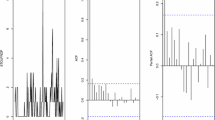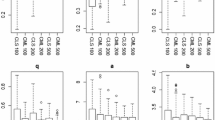Abstract
A bivariate integer-valued autoregressive time series model of order one is introduced. Regression coefficients of the model are random variables so the interaction between processes is stochastic. The dependance is achieved through survival components which are based on the binomial thinning operator. General form of the model is considered where counting series, which determine the survival components, are generated by different binomial distributions. Due to a large number of parameters, generalized method of moments and conditional maximum likelihood methods are suggested for parameters estimation and their asymptotic properties are established. Possible application of the model is discussed on real data.

Similar content being viewed by others
References
Al-Osh MA, Alzaid AA (1987) First-order Integer-valued autoregressive (INAR(1)) process. J Time Ser Anal 8:261–275
Alzaid AA, Al-Osh MA (1988) First-order integer-valued autoregressive (INAR (1)) process: distributional and regression properties. Stat Neerl 42:53–61
Brännäs K, Nordström J (2000) A Bivariate Integer Valued Allocation model for guest nights in hotels and cottages., Umea economic studies 547Umea, Sweden
Brännäs K (2001) Estimating and testing in integer-valued AR(1) models. Appl Stoch Models Bus Ind 17:277–291
Brockwell P, Davis R (1991) Time series: theory and methods. Springer, New York
Brockwell P, Davis R (2002) Introduction to time series and forecasting. Springer, New York
Davis RA, Dunsmuir WTM, Wang Y (1999) Modelling time series of count data. In: Ghosh S (ed) Asymptotics, nonparametrics and time series. Marcel Dekker, New York, pp 63–114
Dewald LS, Lewis PAW, McKenzie E (1989) A bivariate first-order autoregressive time series model in exponential variables (Bear(1)). Manag Sci 35(10):1236–1246
Fokianos K (2010) Some recent progress in count time series. J Theor Appl Stat 45:49–58
Franke J, Rao TS (1993) Multivariate first-order integer-valued autoregressions. Technical Report, Mathematics Department, UMIST
Freeland KR (2010) True integer value time series. Adv Stat Anal 94:217–229
Hansen PL (1982) Large sample properties of generalized method of moments estimators. Econometrica 50:1029–1054
Koopman SJ, Lucas A, Scharth M (2012) Predicting time-varying parameters with parameter-driven and observation-driven models, Tinbergen Institute Discussion Paper, TI 2012–02014, Amsterdam
Latour A (1997) The multivatiate GINAR(p) process. Adv Appl Probab 29:228–248
McKenzie E (2003) Discrete variate time series. In: Rao CR, Shanbhag DN (eds) Handbook of statistics. Elsevier, Amsterdam, pp 573–606
Newey WK, West KD (1987) A simple, positive semi-definite, heteroskedasticity and autocorrelation consistent covariance matrix. Econometrica 55:703–708
Pedeli X, Karlis D (2011) A bivariate INAR(1) process with application. Stat Model 11:325–349
Pedeli X, Karlis D (2013) Some properties of multivariate INAR(1) processes. Comput Stat Data Anal 67:213–225
Ristić MM, Nastić AS, Bakouch HS (2012) A new geometric first-order integer-valued autoregressive (NGINAR(1)) process. J Stat Plan Inference 139:2218–2226
Ristić MM, Nastić AS, Jayakumar K, Bakouch HS (2012) A bivariate INAR(1) time series model with geometric marginals. Appl Math Lett 25:481–485
Ristić MM, Nastić AS (2012) A mixed INAR(p) model. J Time Ser Anal 33:903–915
Rosenblatt M (1974) Random processes, 2nd edn. Springer, Berlin
Steutel FW, van Harn K (1979) Discrete analogues of self-decomposability and stability. Ann Probab 7:893–899
Weiss HC (2008) Thinning operations for modeling time series of countsa survey. Adv Stat Anal 92:319–341
Weiss CH, Kim HY (2008) Parameter estimation for binomial AR(1) models with applications in finance and industry. Stat Pap 54:563–590
Zheng H, Basawa IV, Datta S (2007) First-order random coefficient integer-valued autoregressive processes. J Stat Plan Inference 137:212–229
Acknowledgments
The author is grateful to the referees for valuable comments. The research of the author has been supported by Grant of MNTR 174026.
Author information
Authors and Affiliations
Corresponding author
Rights and permissions
About this article
Cite this article
Popović, P.M. A bivariate INAR(1) model with different thinning parameters. Stat Papers 57, 517–538 (2016). https://doi.org/10.1007/s00362-015-0667-1
Received:
Revised:
Published:
Issue Date:
DOI: https://doi.org/10.1007/s00362-015-0667-1




